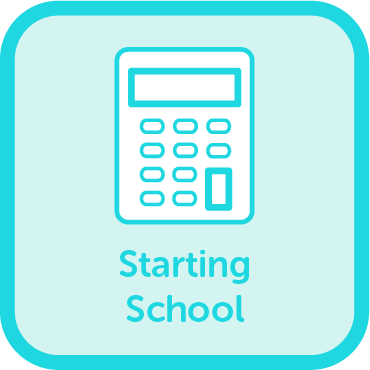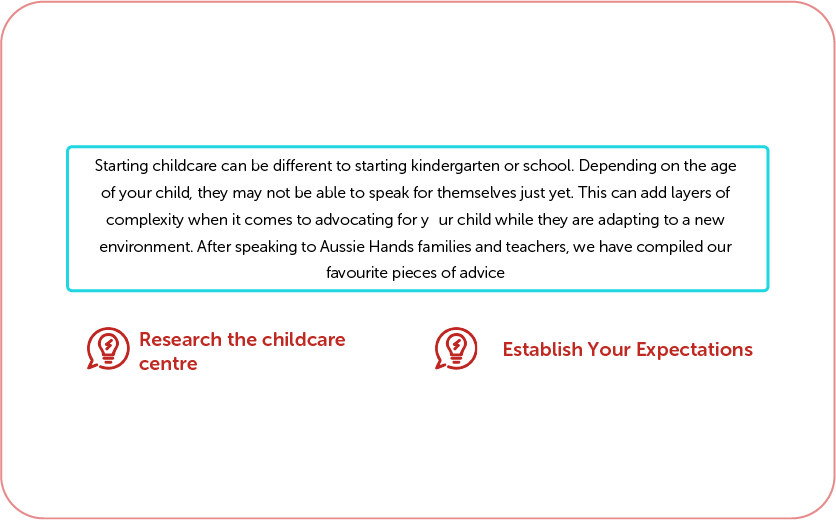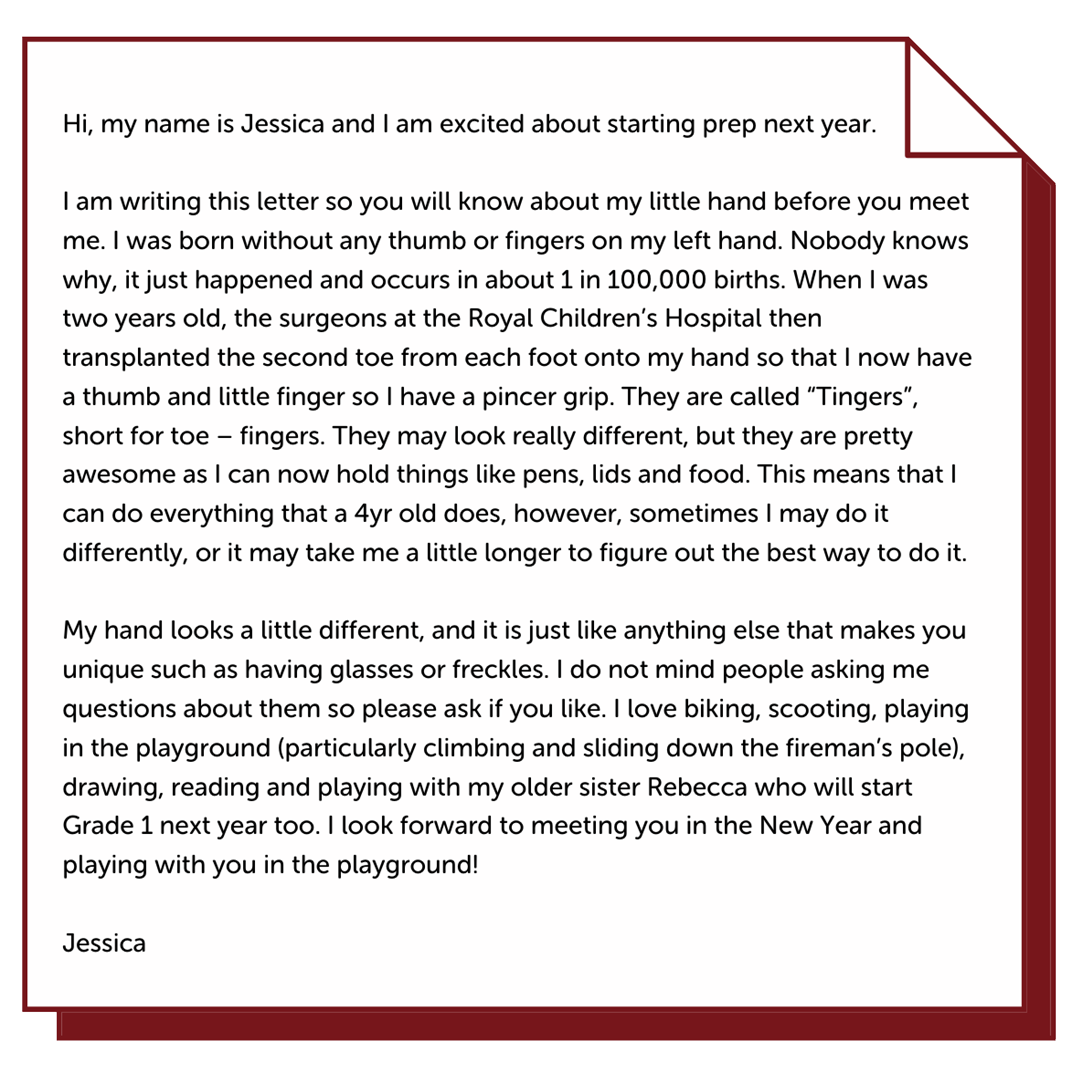STARTING SCHOOL & PARTICIPATING IN ACTIVITIES
Whether transitioning to childcare, kindergarten, school or high school you may have many questions about how to prepare your child, what you can do to help them adapt and prepare their teachers.
Starting primary school is a significant milestone in your child’s life. For children with hand a difference and their parents, it can be a time full of questions and uncertainty.
This topic aims to make the transition to kindergarten or school a little easier. It includes some of the most frequently asked questions and practical advice from parents who have been there. We encourage you to reflect on the information provided and to make decisions based on what best suits you and your child.
While we will focus on kids starting primary school here, the advice can be applied to many different situations where your child is meeting a new group of people.

Starting Childcare
With approximately 60% of Aussie kids going to childcare before starting school, their needs may be a little bit different, especially if they are not able to speak for themselves yet. Here are tips from Aussie hands parents and teachers to prepare your child Starting Childcare.
Starting School

Build a relationship with your child’s teacher
A good relationship starts with open communication. The class teacher is key to a child’s successful transition to kindergarten and school. From the outset, Aussie Hands parents suggest fostering a good relationship with the teacher and maintaining it by staying in touch and being available for advice if needed. Encourage the teacher to come to you throughout the year if they have any issues or concerns.
‘Making yourself available and involved in what your child is doing at school and keeping communication open by “checking in” every now and then is a good thing.’
Should you talk to the teacher about your child’s hand difference before the start of the kindergarten/school year?
Yes. It’s a good idea to contact your child’s teacher before the kindergarten/school year starts. You can talk to them about your child’s hand difference and raise anything you think the teacher should be aware of.
‘I found it was good to have a brief conversation early about the hand difference. It made me feel more at ease that the staff were looking out for her. The teaching staff have been interested to learn about hand differences – no teachers I have come across yet had seen it before.’
Aussie Hands dad Andrew to share why he thinks it’s important to talk to your child’s school.
What types of things should you mention to the teacher to ensure the best support for your child?
You can let the teacher know that your child is capable and able to do all the things that other children do. Your child might do some tasks differently, but they can master them all the same. Other parents have advised the teacher to encourage their child to do things independently and have suggested letting their child be the guide with the teacher only stepping in to help if other options have failed.
It can also be good to inform the teacher about any tasks you feel your child may need support with, for example, tying up shoelaces. You might want to go over any aids or gadgets they have and how and when they are used.
‘We went through the amenities (toilet, water fountain), left-handed scissors and other equipment in the classroom. I also discussed things she needed help with, like putting on a jumper, and requested special approval from the Principal so that she can wear Velcro shoes and not shoelace ones like everyone else had to.’
You can also talk to the teacher about what words you and your child feel most comfortable using to describe their hand difference. For example, ‘hand difference’, lucky fin’ or ‘little hand’. Explain to the teacher if there is a specific term that your child uses.
‘My daughter said two kids asked what happened to her hand and she said: “I was born like this, I didn’t grow my fingers properly when I was in my mummy’s tummy.” The kids just said “Oh, ok.” and they played together.’

Take control of how your child introduces their hand difference
Children are naturally curious. They want to know ‘why’? They will ask your child why they have a different hand. It is a good idea to ensure your child has a response that they feel comfortable using.
This might be something along the lines of ‘I have a big and a little hand, this was the way I came out of mummy’s tummy’.
‘Other children often ask my daughter about her limb difference at school. She practiced explaining it to kids before she started so she would be used to that.’
On a more practical level, think about what activities that your child will be required to do at kindergarten and school and support them to practice before commencing. For example, many parents have got their child to practice cutting paper with scissors and taking their shoes on and off.
Aussie Hands parent Valerie shares what she did to prepare her daughter for questions at school.
Should you introduce the topic of hand difference to your child’s class?
It’s a personal decision and one to be made after thinking about what would be best for your child. It’s good to include your child in these conversations and listen to what they are comfortable with.
Many parents find addressing the issue of difference to be positive because it allows the discussion to be guided by an adult, rather than peers in the playground.
How can the topic of hand difference be introduced to your child’s class?
Some parents recommend getting an adult to talk to the class about hand difference. This could be a parent, the teacher or an adult living with a hand difference.
Your child could also talk to the class if they want to. This approach would suit a child who is confident and doesn’t mind being the centre of attention and being bombarded with questions.
You could also show YouTube videos, read books and talk about inspirational people such as Aussie Hands Patron Jessica Smith.
Focussing more generally on diversity and difference puts hand difference on the agenda in a non-confrontational way. It would suit self-conscious children and those who don’t like the spotlight.
One way to do this is to get the class to discuss the topic of ‘what makes us different?’ This could involve one child saying he is Italian-Australian or has red hair. The main conversation that the parent or teacher should emphasise is that we are all different and this is ok. Different is normal.
‘The teacher asked the class about what makes you different and special? Mike was unaware of this activity and to my amazement his response was, MY HAND!! This made me smile and tear up all at the same time.’
How about writing a letter of introduction, to be given to my child’s peers and parents?
Writing a letter to introduce your child to their peers and their parents is recommended by many Aussie Hands families. Benefits include informing the parents so they can talk to their child about the topic of hand difference.
Ask that the letter be given to each family to take home. As with the storybook, make the letter about more than just hand difference. Include a range of information about your child, what they like to do, what they are good at and some photos.
Here is an example letter written by Aussie Hands Mum Toni for her child Jessica before she started school:
Other ideas for introduction letters can be found online. On the website Born Just Right there is a letter by Jordan’s Mum which offers a different approach. Rather than talk about the child and what they like to do, it focuses on advising parents how to respond to their child’s questions.

Introduce the topic of hand differences and other differences through stories
Are children’s books about difference a good way to introduce the topic of hand difference to the class?
Reading books to the class or at home can provide a great way to engage children about difference. These books can also be an excellent way to prepare your child for kinder and school. Many parents have said reading the books at home was very supportive for their child. This includes situations where they have found the questions of other children difficult to manage. The books have supported them to not feel so alone in their experience.
You may like to create your own story book with your child that details their own experiences, or you could use one of the books below.
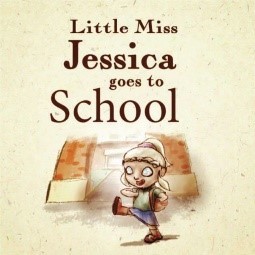 Little Miss Jessica Goes to School, by Australian author Jessica Smith
Little Miss Jessica Goes to School, by Australian author Jessica Smith
Born with a left hand, Jessica’s story reinforces to kids that being different is okay. The book can be purchased directly from Jessica’s website.
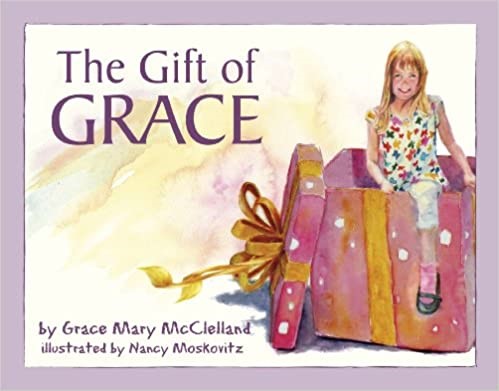 The Gift of Grace by Grace Mary McClelland
The Gift of Grace by Grace Mary McClelland
Written by nine year old Grace who has experienced bullying, this book explains why Grace’s little hand makes her special.
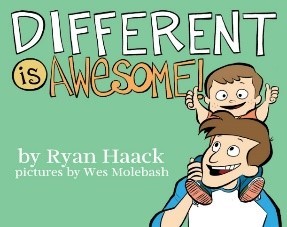 Different is Awesome by Ryan Haack
Different is Awesome by Ryan Haack
An American, Ryan was born without his left forearm. He has a great website from which the book can be purchased.
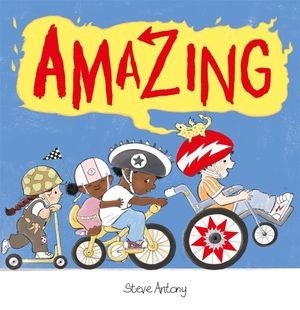 Amazing by Steve Antony
Amazing by Steve Antony
This is a story that celebrates friendship, kindness, understanding and diversity.
 I am Sheriuana, Book 1: We Are Beautiful by Sherylee Honeyghan
I am Sheriuana, Book 1: We Are Beautiful by Sherylee Honeyghan
Sheriauna is a little girl with heaps of personality who teaches us how to be kind and inclusive of everyone.
 Born Just Right by Jordan Reeves & Jen Lee Reeves
Born Just Right by Jordan Reeves & Jen Lee Reeves
This one is for the older kids, with a reading age of 9-13. Jordan tells her story of growing up with an upper limb difference, and how she never let that stop her. Jordan is
the founder of the organisation Born Just Right, and inventor of Project Unicorn – a prosthetic that shoots glitter.
 What Happened to Your Hand, by Australian author Andrea Murray
What Happened to Your Hand, by Australian author Andrea Murray
A delightful book that helps children find out about physical differences. The author shares her childhood experiences to help promote positive interaction and acceptance among children.
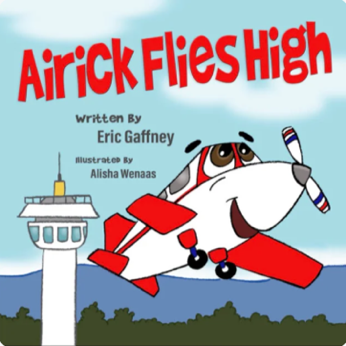 Airick Flies High by Eric Gaffney
Airick Flies High by Eric Gaffney
In a book symbolic of the author’s career as a pilot with one hand, Airick the plane learns how to fly with one wing shorter than the other!
 It’s Okay to be Different, by Todd Parr
It’s Okay to be Different, by Todd Parr
The book teaches about diversity and tolerance. The storylines include a kangaroo with a dog in her pouch. The storylines can be the starting point to ask children if they know anyone like the characters in the book or if they see a character resembling themselves.
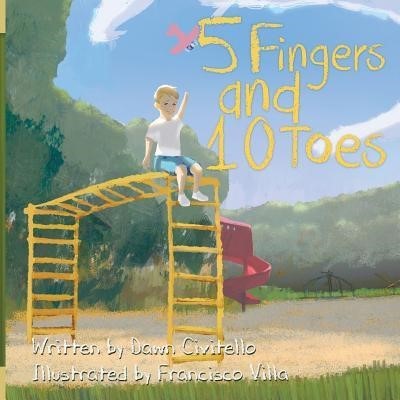 Five Fingers and Ten Toes by Dawn Civitello
Five Fingers and Ten Toes by Dawn Civitello
A great book about accepting everyone for who they are. Dawn Civitello is a mum and teacher who wishes to raise an awareness of limb differences through this book.
 Look What Kate Can Do by Katie & Paul Leatherwood
Look What Kate Can Do by Katie & Paul Leatherwood
Katie tells her story of growing up with one hand.
Are there any cartoons or films the class can watch which talk about difference?
Yes, here are just a few examples of kids cartoons and films that talk about difference.
Maya and Miguel
When Maya met Andy. This cartoon is about a new boy Andy who moves into the neighbourhood. Maya doesn’t know if he will be able to do sport activities and so tries to help by getting the gang to do everything but sport together. But as it turns out Andy can do all the things that the others in the gang can too!
Finding Nemo
In the movie Finding Nemo (2013) which is about the adventures of a fish who happens to have one fin shorter than the other. If you’ve seen Finding Nemo then you know all about Nemo’s ‘lucky fin’ and how being made a little differently doesn’t stop him from accomplishing anything he sets out to do.
Luca
Then the movie Luca (2021) casually includes hand difference creating a more inclusive and accepting society. When Luca asks Massimo how it happened, he says in a scary voice, ‘A sea monster ate it.’ After a beat, he reveals he was just kidding and that he was born like that.
Will my child’s hand difference make them a target of bullies?
Bullying is an issue that many children face, including both those with and without a hand difference. Understandably, parents of children with a hand difference are concerned that this will make their child a target of bullies. Check out our resource on Bullying.
Starting High School
Starting high school is a big change, and something that makes almost everyone nervous. That includes both kids and their parents! But it’s also an exciting time. High school is also about experiencing new things and making new friends.
Here are our tips for to help kids make the transition a little easier.






